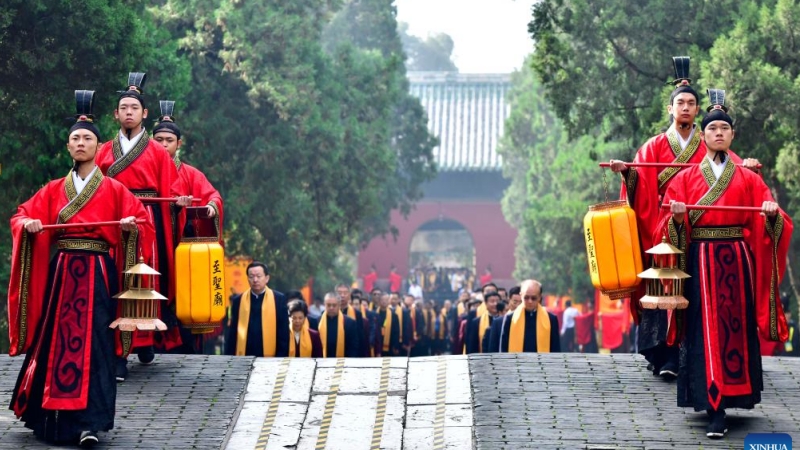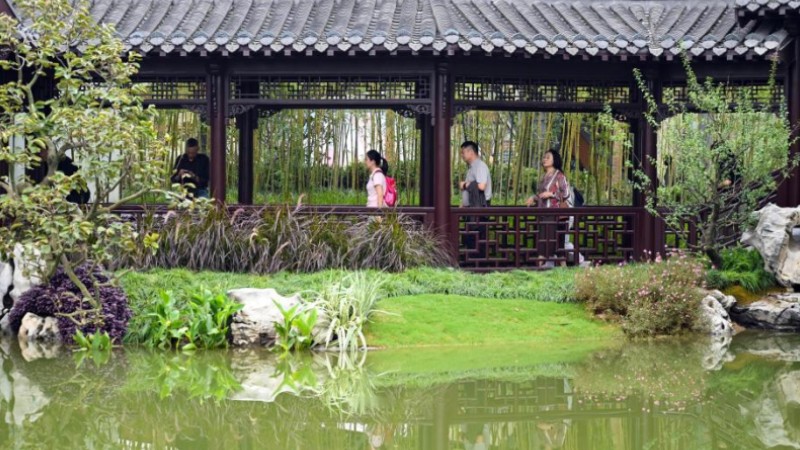Young relic 'doctor' breathes new life into Three Gorges cultural relics
Qin Dan serves as a “doctor” for cultural relics, much like how a medical doctor cares for patients. She operates within the Three Gorges Cultural Relics Science and Technology Preservation Base, situated in the Nan’an district of southwest China's Chongqing Municipality.
She serves as a researcher at a key laboratory specializing in the research and control of harmful organisms affecting cultural relics, within the preservation base. The facility is part of the Chongqing China Three Gorges Museum.
Born in 1992 in Chengdu, the capital of southwest China’s Sichuan Province, Qin had always aspired to become a medical doctor or pursue a career in biomedical or pharmaceutical research. During her college years, she never envisioned herself working in cultural relic preservation.

Qin Dan collects mildew samples from cultural relics. (Photo provided by the interviewee to West China Metropolis Daily)
When Qin was on the verge of completing her doctoral degree at Southwest University in Chongqing and began job hunting in 2021, she came across a notice about the Chongqing China Three Gorges Museum recruiting a researcher. Initially, she didn’t pay much attention to it. However, during a chance visit to the museum, she saw the notice again and decided to apply for the position.
“I made the decision to pivot my career in just over two hours, driven by two key factors. Firstly, my deep curiosity about archaeological work and the protection of cultural relics. Secondly, my research background aligned with the preservation base’s focus on combating mildew and insects affecting cultural relics, as both involve microorganisms,” she explained.
Qin primarily concentrates on researching new technologies, methods, and equipment for preventing and managing organic relics at the preservation base. She likens her role to that of a doctor, with the cultural relics being her patients.
Her daily tasks involve examining cultural relics and categorizing any mildew present on them. Through these efforts, she has compiled a comprehensive database of mildew samples.
“Mildew primarily affects paper, wood, textile, and leather cultural relics. To date, we have compiled a database containing over 300 mildew samples,” Qin explained, noting that these samples predominantly originate from cultural relics within the Three Gorges Reservoir area.
She continued, “I believe cultural relics serve as a ‘bridge’ for us to engage in a dialogue with ancient civilizations. Through these artifacts, we can gain deeper insights into the wisdom of our predecessors, their exquisite craftsmanship, and the culture of their time.”
In contrast to traditional cultural relic restoration techniques, Qin places a greater reliance on technology. “Technology ensures a more robust, scientifically grounded, and precisely targeted approach to preserving cultural relics,” she emphasized.
According to Qin, in the past, it used to take at least three to five days to detect mildew on an ancient ceramic fragment. However, now, a method based on ATP (adenosine triphosphate) bioluminescence, jointly developed by Qin and her colleagues, can deliver results for detecting mildew on cultural relics in just 15 seconds.
Qin’s team comprises 15 members, including two colleagues who, like her, have earned doctorates. They represent various disciplines, such as archaeology, microbiology, entomology, pharmacology, chemistry, plant protection, and more. “These disciplines cover all aspects of researching harmful organisms affecting museum collections,” she noted.
The team has achieved remarkable research outcomes in the study of controlling harmful organisms on cultural relics. They have undertaken 24 research projects, including 12 at the provincial and ministerial levels, published 22 academic papers, and obtained 13 authorized patents.
Furthermore, the preservation base has provided services, including the detection and analysis of harmful organisms on cultural relics, as well as consultation on control techniques, to over 50 cultural heritage institutions and museums across China.
“In the past, the protection and restoration of cultural relics relied heavily on the experience of restorers. Now, we also harness technology to enhance the effectiveness of preserving and utilizing cultural relics,” explained Zhao Xiongwei, deputy director of the Three Gorges Cultural Relics Science and Technology Preservation Base.
“By safeguarding cultural relics, we can genuinely maximize their utility and contribute to their revitalization,” Qin emphasized, adding that being a relic “doctor” is her lifelong vocation.
Photos
Related Stories
- British Museum facing renewed calls to return cultural relics
- Xi'an Museum brings cultural relics to life with digital technologies
- Technology enhances protection of cultural relics in China
- Digital technologies revive murals in Yongle Palace, China's Shanxi
- Guardians bring cultural relics closer to general public
- U.S. returns 2 illegally transported cultural relics to China
Copyright © 2023 People's Daily Online. All Rights Reserved.









